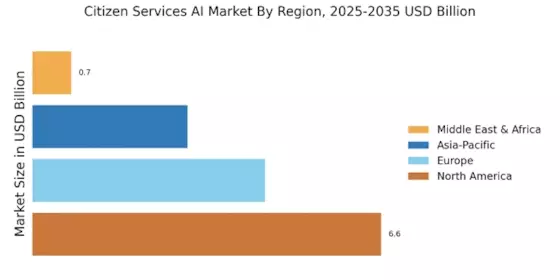The Citizen Services AI Market is currently characterized by a dynamic competitive landscape, driven by the increasing demand for efficient public service delivery and enhanced citizen engagement. Major players such as IBM (US), Microsoft (US), and Accenture (IE) are strategically positioning themselves through innovation and partnerships. IBM (US) focuses on integrating AI with cloud services to streamline government operations, while Microsoft (US) emphasizes its Azure platform to support scalable AI solutions for public sector clients. Accenture (IE) is leveraging its consulting expertise to drive digital transformation initiatives across various government agencies, thereby enhancing operational efficiency and citizen satisfaction. Collectively, these strategies contribute to a competitive environment that prioritizes technological advancement and service optimization.
In terms of business tactics, companies are increasingly localizing their operations to better serve regional markets, which appears to be a response to the diverse needs of citizens across different geographies. The market structure is moderately fragmented, with a mix of established players and emerging startups. This fragmentation allows for a variety of solutions tailored to specific governmental needs, while the collective influence of key players fosters a competitive atmosphere that encourages innovation and collaboration.
In August 2025, IBM (US) announced a partnership with a consortium of European governments to develop AI-driven platforms aimed at enhancing public safety and emergency response systems. This strategic move is significant as it not only showcases IBM's commitment to leveraging AI for societal benefits but also positions the company as a leader in the European public sector AI landscape. The collaboration is expected to yield advanced predictive analytics capabilities, thereby improving response times and resource allocation during emergencies.
In September 2025, Microsoft (US) launched a new initiative aimed at integrating AI tools into local government operations, focusing on improving citizen engagement through personalized services. This initiative is crucial as it reflects Microsoft's strategy to deepen its penetration in the public sector by providing tailored solutions that enhance user experience. By utilizing AI to analyze citizen data, local governments can offer more relevant services, thereby fostering a more engaged and satisfied citizenry.
In July 2025, Accenture (IE) expanded its AI capabilities by acquiring a leading analytics firm specializing in public sector solutions. This acquisition is indicative of Accenture's strategy to bolster its service offerings and enhance its competitive edge in the Citizen Services AI Market. By integrating advanced analytics into its existing portfolio, Accenture aims to provide more comprehensive solutions that address the evolving needs of government clients, thereby solidifying its position as a key player in this space.
As of October 2025, the Citizen Services AI Market is witnessing trends that emphasize digitalization, sustainability, and the integration of AI technologies. Strategic alliances among key players are increasingly shaping the competitive landscape, fostering innovation and collaborative solutions. Looking ahead, it is likely that competitive differentiation will evolve, shifting from traditional price-based competition to a focus on innovation, technological advancement, and supply chain reliability. This transition underscores the importance of adaptability and forward-thinking strategies in maintaining a competitive edge in the rapidly evolving market.


















Leave a Comment